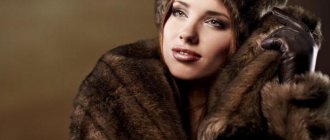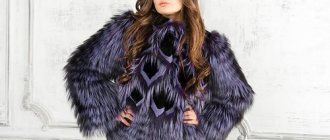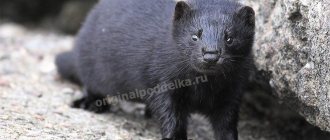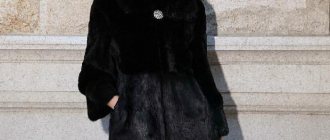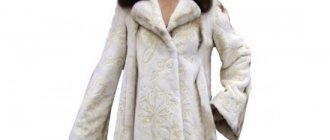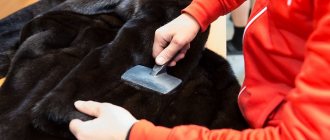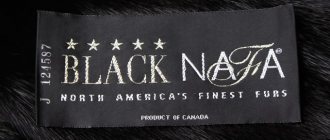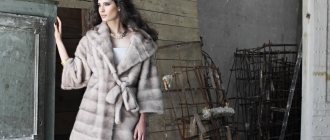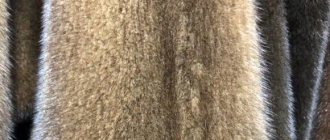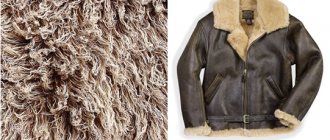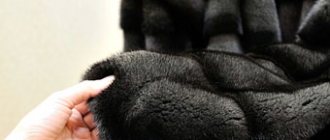Mink fur has been one of the most popular furs for many years.
Today, thanks to the careful work of breeders over many years, a huge number of its colors can be found on the fur market - from bluish-black to snow-white. Nevertheless, from year to year, natural and natural colors of mink coats : brown, pastel, beige. Classics of the genre are black fur coats, white mink, as well as gray-blue shades, which look stunning and literally drive fashionistas around the world crazy.
Dyed fur models are also in demand, for example, mink coats in orange, green, yellow, blue, and purple. Such exotic colors are an excellent option for those who are not afraid to experiment. However, in the pursuit of originality, one should not forget that dyeing significantly degrades the quality of the fur and such a fur coat will last at best a couple of seasons, and at the same time manage to go out of fashion.
It is simply unrealistic to describe all the tones and half-tones of the most beautiful mink fur available in nature, so we will limit ourselves to just getting acquainted with the basic color schemes.
Origin of the species and description
Photo: Mink
Mink is a small animal with smooth, predominantly brown fur. It is a valuable representative of the mustelid family and belongs to carnivorous mammals. This animal does not exceed fifty centimeters in length, of which only one tail takes up about fifteen centimeters.
There are two types of mink in the wild:
- European;
- American.
These types of minks have some differences in appearance and anatomical features, but they are insignificant. As a result of evolution and identical living conditions, these animals acquired high similarity. A characteristic feature of all minks is the presence of a special membrane between the toes. This is what makes animals excellent swimmers.
Interesting fact: The European and American species originated from completely different ancestors. The European mink evolved from the Siberian mink, while the American mink is considered a close relative of the martens.
For a very long time, the most important commercial object was the European mink. However, today it is slowly but surely being replaced by the American one. This is due to a significant reduction in the population of the species, the importation and rapid breeding of the American animal.
Interesting fact: This representative of mustelids provides seventy-five percent of the world's need for fur. There is a simple explanation for this figure - minks reproduce remarkably well in captivity.
Gray mink coats
This color of a mink coat can be represented by one of several dozen shades available. The fur undertone of such a product can be bluish or white, but the most fashionable trend remains the graphite version.
Gray mink is universal, not as difficult to care for as light shades of fur, and at the same time looks very graceful. Plus, gray mink coats can even visually rejuvenate their owner. The shortened version is the ideal solution for a young girl.
Appearance and features
Photo: Animal mink
Mink is the closest relative of weasels, ferrets, and weasels. The natural species of the animal are European and American, but in captivity scientists have bred other varieties that have improved characteristics. Minks are small animals with an elongated body. The body is characterized by good flexibility, and its length, on average, is forty-three centimeters.
Video: Mink
These animals have a relatively small but very fluffy tail. Its length ranges from twelve to nineteen centimeters. The weight of the predator is no more than 800 grams. Thanks to these parameters, an animal in nature can penetrate various gorges, quickly hide in case of danger and easily float on the water.
The most valuable thing for a person in a mink is fur. The small predator has very beautiful, thick fur with a dense down. The down prevents the animal from getting wet even after being in the water for a long time. Another advantage of fur is its “demo seasonality”. The difference between summer and winter cover is very small. The color of the animal can be brown, light red, dark brown and even black. The color is evenly distributed, only on the stomach it may be a little lighter.
Minks have a narrow muzzle and small rounded ears. The muzzle is slightly flattened on top, and the ears have a rounded appearance and practically do not show from under the fur. The webbing between the toes is clearly visible. They are especially noticeable on the hind limbs. These animals are also characterized by the presence of a white spot. It is usually placed on the chin, but can also be placed on the chest.
Field of all colors of natural rabbit fur - from white to black
Nowadays, rabbit fur is the most accessible and inexpensive material used for sewing and finishing women's and men's clothing. It has the ability to retain heat well at sub-zero temperatures, good flexibility during processing due to the plasticity of the skins, and ease of care. Thanks to dyeing, you can find wardrobe items and accessories made from rabbit fur in almost all colors.
Among the variety of breeds of these animals, there are so-called “fur” ones, the skins of which are used in the clothing industry:
Black-brown, resembling silver foxes in color
Russian ermine, whose main field of fur is white with brown or black splashes on the paws and tail
Rex, which has short soft pile, similar in tactile sensations to plush, black, blue, brown or white
Chinchilla, with a gray-blue color, the shade of which can be dark, medium and light.
All colors of products made from natural rabbit fur look as bright and rich as possible, since the material can be dyed without problems.
Where does the mink live?
Photo: American mink
Previously, the habitat of minks was quite wide. It extends from Finland to the slopes of the Ural Mountains. Over time, the animals spread throughout France and Spain. However, a lot has changed since those times. There are fewer and fewer representatives of the mustelid family. Their populations have declined significantly across much of their historical range, and in some regions they have disappeared completely.
Today, the official habitat of European minks consists of several fragments: Ukraine and Russia, northern Spain, western France, and some areas of Romania. The animal can be found at an altitude of up to one thousand two hundred meters from sea level. The American species is common in North America. However, it was also introduced to Europe and Northern Asia. Over the past ten years, more than four thousand American minks have been imported. Moreover, this species is actively bred on various fur farms.
In modern habitats, the number of minks is in significant decline. An exception is Romania and several Russian regions: Arkhangelsk, Vologda, Tver. However, scientists express fears that soon even there the population of these animals will begin to decline. European minks are disappearing not only due to poor ecology or environmental pollution, but due to the rapid spread of the American species.
Bear: product colors for men and women
Bear fur is valuable due to its undeniable practicality and functionality. For a long time, outerwear for the stronger sex was made from the skins of this animal, since the material is extremely massive and bulky. But modern technologies, as well as fresh design solutions, make it possible to create elements of both men's and women's wardrobes that can unobtrusively emphasize the advantages and hide the flaws of the figure.
The bear skin consists of two protective layers: soft, short, thick pile with thermal insulation properties, combined with long and sparse piles with a water-repellent effect. This means that winter clothes made from such material will not only keep you warm in the frosty cold, but will also protect you from sudden snowfall, sleet or rain.
Nowadays, vests made from brown bear skin are popular, they perfectly fit into the oversized and unisex style. Due to their massiveness and large mass, fur coats and sheepskin coats made from this material are more rare than common. Its natural shades vary from fawn to brown-brown and almost black.
But designers and stylists annually offer several styles of women’s fur coats made from white bear fur, since the bulky appearance of the material is well neutralized by a light, delicate tonality.
What does a mink eat?
Photo: Black mink
A mink's daily diet may consist of:
- Mouse-like rodents: water rats, field mice;
- Fish. The animals will not refuse perches, minnows, and brown trout. In general, they can eat almost any fish;
- Marine animals: crayfish, mollusks, various marine insects;
- Amphibians: tadpoles, small toads, frogs, eggs.
Animals living close to populated areas often visit people for treats. They sneak into barns, chicken coops and deftly catch poultry. If an animal is very hungry, then it may not be shy about human food waste. However, most members of the family still prefer to eat fresh food. If there is no such thing, then they can even starve, but no more than four days.
Minks can often be seen in trees. There they can feast on bird eggs. The average mink eats about two hundred grams of food per day, preferably fresh. If during a hunt the animal comes across large prey, then it can leave it for hungry times or for the winter. The prey hides in a special shelter.
Minks are convinced predators. However, if the hunt is unsuccessful, they may for some time eat food that is not entirely typical for them: berries, roots, mushrooms, seeds. If the animal is domesticated, then people feed it with special food (dry and wet) and fish fillets.
Mink coat color pastel
Pastel-colored mink, which has variations from beige to light brown, also belongs to the same color scheme. The underfur of such fur has a bluish or more valuable lilac tint. A delicate mink coat in pastel color can decorate the most discerning fashionista. Another advantage of outerwear made from this kind of fur is its greater durability in comparison with products made from fur in cold shades - it also turns yellow, but its yellowness looks more elegant.
Features of character and lifestyle
Photo: Mink animal
Minks live mainly in forest areas, near water sources: rivers, reservoirs, lakes. They prefer to live, breed and hunt in relatively small and cluttered areas. They practically do not appear in cleared areas, beaches and open areas. They love to build their nests in reed thickets and bushes.
The animal creates holes on its own or uses existing holes in the ground: natural depressions, small cracks, abandoned rat holes or hollows. The animal constantly uses its home. He can leave it only in two cases: flood, lack of food in the winter.
The burrows are usually small, but divided into several zones. There is a main sleeping area, a restroom and several exits. One exit necessarily leads to a water source, the second – into the thicket. The burrows are lined with available natural materials: feathers, moss, leaves, dry grass.
Fun Fact: According to an ethological study done in the 60s, minks have the highest visual learning skills. In this skill, they surpassed cats, skunks and ferrets.
This animal's peak activity occurs at night. However, if the night hunt was unsuccessful, the mink may be active during the day. The animal spends most of its time on land and searches for food. In winter, these animals are forced to walk more, because it becomes more difficult to find suitable food. The animal also devotes a lot of time to swimming. It is excellent at traveling long distances through water, diving, and deftly catching fish and amphibians.
The nature of wild predators is unfriendly, but not aggressive. Minks prefer a solitary lifestyle and rarely come close to humans. It is very difficult to see such an animal in captivity. Its presence can only be indicated by characteristic footprints on the soil.
Blue mink coat
To obtain the impeccable appearance of blue mink fur and produce such an original product as a blue mink coat, selection alone is not enough, so manufacturers subject it to additional processing that is harmless to it. Most often this is the coloring of the underfur and the tinting of the long guard hairs. The color of mink coats shown in the photo is most suitable for brunettes and brown-haired women.
Social structure and reproduction
Photo: Minks in nature
The mating season for minks usually lasts from February to April. At this time the animals are very active. Several males can chase one female at once. They compete with each other and squeal funny. Sometimes there are fierce battles for the lady of the heart. When the female is fertilized, the male leaves her. Adults live separately after mating.
The entire pregnancy of a female animal lasts relatively short - about forty days. Offspring are usually born by May. At one time, the female reproduces no more than seven babies. By mid-summer, small animals reach almost half the size of an adult. In August they grow to their final size. At the same time, the female stops feeding her cubs with milk. They learn to get food on their own, their diet becomes entirely meat-based. By autumn, the offspring leaves the mother's burrow.
Interesting fact: Minks reach sexual maturity at ten months. Until the age of three, these animals have the highest level of fertility. Over time, the fertility of females gradually decreases.
The total lifespan of small predators is no more than ten years. However, in captivity, minks can live much longer - more than fifteen years. They quickly adapt to home conditions, but even after many years they do not become completely tame.
Mink coat in cappuccino color
A constant fashion hit is a cappuccino-colored mink coat. Outerwear made from fur of this color is universal - it looks great on women, regardless of their age and body type. In addition, the pleasant pastel color of mink coats, photos of which are presented below, favorably sets off a light tan of the face and does not emphasize the excess whiteness of pale skin, which makes the coat suitable for the fair sex of various color types.
Darker colors of mink coats of this color are an excellent option for middle-aged women, but young girls should give preference to more delicate light colors.
Natural enemies of minks
Photo: Mink animal
Natural enemies of minks include:
- Predatory mammal animals. A small animal can be killed and eaten by all predators that are larger and stronger than it. These include lynxes, foxes, bears, and wolves. But most often the mink becomes a victim of the river otter. The otter swims better and lives next to minks, so they are cleverly caught at night and during the day. Otters can dine not only on an adult individual, but also on its offspring;
- Birds of prey. Mainly the enemies are large birds: owls, eagle owls, hawks. When an animal hunts mice at night, an eagle owl or an owl can catch it, and during the day a hawk can lie in wait for a mink;
- American mink. Minks have interspecific competition. As zoologists have found out, the American species is deliberately destroying the European one in order to free up territory for itself and its relatives. However, the appearance of an overseas guest made it possible to shift the attention of hunters from the European mink;
- Human. The most dangerous enemy that intentionally, and sometimes unintentionally, destroys these animals. Today, the only thing that saves minks from death is that they began to be raised on special farms for fur.
Interesting fact: According to biologists, minks do not often become victims of predators. The main factors leading to the death of animals are hunger, disease and parasites.
Mink coat powder color
One of the representatives of everyone’s favorite classic is a powder-colored mink coat in its different variations. She enjoys the well-deserved attention of many fashionistas, regardless of their age. “Powdery” are considered shades in the color range from rich beige to “coffee with milk”.
Fur beauty in light colors, as a rule, is reserved for special occasions - weddings, going out. However, such a mink can (but is not very advisable) be used every day, but very carefully, since this product is easy to get dirty.
Population and species status
Photo: Mink in summer
Minks are the main source of fur. Their fur is valued for its high practicality, versatility, and heat resistance. In terms of quality, American mink fur is considered to be of the highest quality than other types. Not so long ago, fur was obtained exclusively by hunting animals. Hunters skillfully set traps in winter, caught adult individuals and obtained their skins. All this has led to a rapid decline in the mink population in their historical habitat.
Very quickly, minks disappeared from many regions, and hunting ceased to satisfy people's needs for fur. From that moment on, minks began to be bred in captivity. And today the main source of fur is fur farms, and not natural animal populations. This significantly improved the situation with the number of minks in the wild, but could not completely solve it.
The population of these animals is still declining. This is influenced by various factors: pollution of water bodies, trapping of animals, interspecific rivalry. Currently, European minks are listed in the Red Books in a large number of regions of their natural range, the IUCN Red Book. Hunting these animals is prohibited in many countries of the world; their numbers and habitats are taken under enhanced protection.
Sable fur color depending on breed
The luxurious and silky fur of this animal gained unfading popularity back in the distant 10th century. For a long time, the material was considered the privilege of kings and royalty, since the price of a product made from it was practically equal to the cost of a good-quality mansion. Being one of the most expensive furs today, sable fur is famous for its high quality, ease of care and long service life (second in this regard only to otter, beaver and fur seal).
The color of sable fur depends on the breed of the animal and is determined by the climatic conditions prevailing in its habitat. To make elements of a winter wardrobe, the skins of the following species of this animal are used:
Barguzinsky , whose fur is a rich dark brown shade, has gray and bluish streaks. Due to such silvery hairs, the material has radiance and shine.
Yenisei , whose skin is distinguished by the presence of several color variations - from caramel brown to milky flesh. Compared to the previous variety, the fur of this animal contains a much smaller amount of silver fibers.
Canadian (North American), whose color range of skins is limited to light yellow shades, is completely free of blue and silver veins.
The most valuable, and therefore the most expensive, is the Barguzin sable, and the most affordable price range is for products made from skins of the Canadian breed.
Mink and everything about it: types, colors, processing, and tailoring
In those days when skins played the role of money, mink was never one of them. The gray-brown skins of small European mink, rather inconspicuous in appearance, were not valued as highly as sable, marten and squirrel. Later, when furs remained only an exclusive material for clothing, attention began to be paid to mink as an alternative to expensive sable and marten. At the end of the 19th century, the larger and more beautiful American mink was brought to European territory, which in the 20s of the 20th century formed the basis of the entire fur-bearing animal breeding industry. Today, the world market for farmed mink is about 50 million skins. Mink farming is a significant sector of the economy of such highly developed countries as Denmark and Finland. And the term “fur coat” in 9 out of 10 cases means a product made from mink. A mink coat is no longer protection from the cold or a family heirloom. This is the first rule of playing like a wealthy respectable woman, a classic of the fashion genre.
“Mink”, like “car”, is a very generalized concept. The difference between two mink coats can be no less than the difference between a red Ferrari and a black Volga. To use automotive terminology, a mink coat has a “power density”, i.e. in our case, the type is mink. Although all farmed mink are based on the same American species, depending on the place of breeding and diet, mink fur from different places has completely different properties, which make it possible to conditionally divide the entire mink market into several types.
Types of mink
Russian mink has high guard hair and thick, high underfur, resulting in a very warm, but somewhat shaggy product. The Scandinavian mink is the most widespread on the planet. Its quantity accounts for 80% of the world market for farmed mink. The main features are an even awn of medium height and dense underfur. Within the group, both higher fur (Finnish selection, marked SAGA FURS®) and low fur (Danish selection, marked KOPENHAGEN FURS®) can be found. There is a very rare variety of Finnish mink - the so-called. "polar" mink. This is a brown mink with a pronounced ridge, with very high underfur and a very high awn, which in appearance is more reminiscent of a sable. North American mink is a low-pile mink with a natural velvet effect, since the low, silky spine is almost hidden in the dense, thick and high underfur. There is a so-called “super-short hair”, when the guard hair is below the underfur and the mink has a plucked appearance. High quality and small quantity on the world market have provided this mink with an exclusive place and a high price niche. North American mink can be of two quality systems: American (AMERICAN LEGEND® MINK brand) and Canadian (NAFA® MINK brand). The best black mink in both cases has its own name: the American one is BLACKGLAMA®, and the Canadian one is BLACK NAFA®.
With the growing popularity of low-pile mink, Scandinavian selection is also striving to reduce the height of the pile, and such mink is becoming more and more common in both Finland and Denmark. The “velvet” type (“velvet”, i.e. translated into Russian as “velvet”) is a low-pile (North American-like) variety, separated into a separate sort at Scandinavian auctions. This is not the quality of the pile (within this variety there are any - rare and thick and defective skins), but the appearance. This mink is sold in a separate catalogue, i.e. essentially like another mink. While the quantity of the opposite - long nap mink - is decreasing, within the normal range there are several lots of it, and it is sold as part of the regular catalogue.
In recent years, mink production has increased significantly in China. According to some sources, the number may be about 15 million skins. Since a lot of different gene pools were imported, farms are scattered across different climatic zones, there is no professional training, and not enough time has passed since the start of work, it is impossible to talk about the existence of a separate type of Chinese mink. China raises mink of all types: Russian, Scandinavian and North American. The cheapest Chinese mink is similar to the Russian one of southern breeding - high, hard, lying spine and very weak underfur. The main volume is made up of dark brown (the easiest to breed) and black mink.
Mink colors
The American mink is an ideal object for selective transformations, because... in its genes it carries a huge number of mutations responsible for fur color. The natural palette of raised mink is very large: from white to black, through all brown and gray-blue tones. The most common mink color is brown. Its shades make up more than half of the color variations of mink. Natural black mink (the Finnish name is “scanblack”, the prefix “scan” is currently exclusively owned by SAGA), like all natural black fur, is in fact only very dark brown. This is noticeable when comparing it with dyed black furs, leather and fabric. Dark brown mink is the Russian STK (“standard dark brown”), and the Scandinavian and American “mahogany” is a symbol of the classic mink coat. Variations of the so-called “wild type” repeat the original natural color - brown with a dark ridge. This color has the most official and “folk” names: “wild”, “demi-buff”, “walnut”, “dark pastel”. The light tones of wild type Scandinavian mink are called “(scan)glow”, the dark ones are called “(scan)brown”. The light gray-brown color is called “pastel”. "Lavender" has a light lilac tint and a light undergrowth.
The next group is gray-blue colors. The undisputed leader of this group is the blue mink “sapphire” and its rare light mutation “violet”. This group includes the well-known “silverblue” and the less common gray mink “blue iris”.
White mink is a rare guest on Russian streets. Much more often you can find darker shades - light beige “pearl” and gray-beige “topaz” (“palomino”).
There are now a large number of different color mutations on the market. The most common of them is the “black cross” mink, in which the black fur of the ridge forms a bright cross on the white skin in the “shoulder” area. The rare variations of the cross are very beautiful - blue (“sapphire cross”) and pastel (“pastel cross”). Crosses are bred in small quantities on the basis of all primary colors. The color of the "jaguar" is reminiscent of the traditional cow - white with black spots.
There are extremely rare mutations of mink, whose worldwide number can be limited to hundreds of skins, for example: gray mink with tiny white inclusions - “stardust”, “cinnamon”, reminiscent of beige milk foam with brown specks on cappuccino cup or marble (“marble”) mink – dark yellow with chocolate stains.
Mink fur processing technologies
Despite the variety of natural colors, mink fur is successfully dyed in various colors. In addition to traditional immersion dyeing and tinting, there are many “complex” multi-layer dyeing: light colors are dyed while reserving the top of the guard hair, obtaining the so-called. “snow tops” - “snow-top” (snowtop), wild-type mink is bleached to a “golden” color. Enhancing the color of natural ridges is often used. A hit of the late 90s was stencil (surface) dyeing of mink to look like “leopard”, “tiger”, etc. The latest development of technologists - “digital” (“digital”) dyeing (the process is computer controlled) allows you to apply any multi-colored patterns to the fur.
Designers are always trying to change the very texture of mink fur. The most common types of fur processing are plucking and shearing. When pinched, the guard hair is removed, leaving a velvety underfur. When shearing, the spine is shortened, but if you run your hand over the skin, especially against the grain, you will feel a tingling sensation. Most often, a combination of plucking + cutting technologies is used. After removing the guard hair, the “velvet” is trimmed to the desired height, or “corduroy” is made from the “velvet” (multi-level cutting technology - “grooving”).
Recently, “high” technologies for processing mink have become widespread - laser cutting (or rather, burning), in which patterns of hair of different heights are applied to the fur, cutting perforation (“lace”), notch perforation. Particularly popular is the processing of the hide into leather and suede for fashionable mink sheepskin coats.
The triumph of technological processing came at the beginning of the millennium. Using a combination of all technologies, a material completely different from fur was obtained from mink. For example, they took two-layer dyed plucked skin and processed it using the “grooving” technology, and as a result they obtained corduroy with different colors according to the depth of the “scars”. Bleaching is very popular: “golden” mink of all shades from cognac to biscuit and the contrast of light underfur (color options from milky to light yellow) with dark hair. At the moment, the most popular option is silver-blue mink with lightened underfur; this color is called “crushed ice” or fume.
Modern dressing technologies have also made it possible to level out the “historical” difference in products made from male and female mink. But even now we have to admit: a product made from males is heavier than a similar product made from females. But you should definitely add: weight is added not so much due to the thickness of the flesh, but due to the number and length of hair.
Technologies for sewing mink fur products
If we return to manufacturing options, then a mink product can be sewn from whole skins or “unraveled.” When unraveled, the skin is cut along the ridge into two parts and “herringbone” at a certain angle into strips 2-3 mm wide, the strips are shifted and stitched. The result is a strip about 1 m long and 5-7 cm wide. When sewing “unfolded,” the modeling possibilities expand; the fur product has no visible joints between the skins and looks “monolithic.” The disadvantages of this technology include some weighting of the product and a huge number of seams that completely hide the quality of the original skin. The generally recognized leaders of the dissolution are manufacturers from China and Greece. They produce 95% of all dissolved products. There is a so-called “figured dissolution”, in which a strip of any shape is sewn from trapezoidal skin. Typically, details made using the figured dissolution technology are elements of product decoration.
Separately, fur knitwear is gaining more and more popularity. This technology, created by Canadian designer Paola Lishman initially for beaver, is, in fact, not “knitting”, but weaving on a special elastic base mesh. Now fur knitwear from mink and other expensive furs is in the collections of the world's best companies.
One of the advantages of mink fur is its amazing practicality. With proper storage and careful handling, a mink coat can last 20-30 years. In terms of wear resistance, mink is equal to sable and is 70% of the standard - otter.
The popularity of mink products is increasing from year to year. Despite the fact that it is the most versatile and widespread of furs, mink never gets boring. Its possibilities for changing textures and colors are truly limitless; its natural beauty has captivated fashion designers. Recent seasons have shown a high interest among fashion trendsetters in the natural palette and natural texture of mink. Today, white, black, brown and blue mink triumphantly walk down the catwalks of Paris, Milan, London, Madrid and New York, deservedly taking their place among the most modern and exclusive materials in the fashion industry.
Source: https://mexaimoda.ru/ru/read/interesting/furs/mink.html
How to spot a fake
Canadian mink is high-quality and expensive fur. It occupies only 5-7% on the world market. Most often, other types of fur are passed off as Canadian. To learn to distinguish them from each other, you need to remember the main characteristics of European, American and Scandinavian minks - these are the species that are usually passed off as elite Canadian.
The second point to remember is the auction number, which is assigned to the fur before being sold at auction. This number, as well as the location of the auction (and for Canadian mink it is always Toronto), must be indicated on the certificate. Before purchasing a fur product, you should definitely ask the seller for a quality certificate. Such an elite product as a fur coat made from Canadian mink must have this document. If the store refuses to provide you with a certificate for some reason, you can safely refuse the purchase, because this is a fake.
And, of course, the BlackNafa brand should be indicated on the fur coat label. If you see the inscription Blackglama on the tag, then they are offering you an American woman. It is also of excellent quality, but differs from the Canadian one. There are also cases when they try to pass off a Canadian mink coat as an outright fake. In order not to fall into the trap and recognize low-quality fur in time, you should pay attention to the following points:
- Fur density. The Canadian has a very dense pile. You definitely won’t be able to push it apart to see the inside with a slight movement.
- A shade of flesh. When you do get there, pay attention to the shade. It should be grayish or beige - this indicates that this is natural, undyed fur. Of course, the Canadian is also tinted, but the flesh always retains its natural shade.
- Toning quality. Take a white handkerchief dampened with water and gently rub it over the surface. If dark marks remain on it, it means that the fur was dyed very poorly and this is not Canadian fur.
- Elasticity. The flesh should be firm and elastic to the touch. If it is dry and rustling, this indicates improper processing of the skins. The lint will begin to fall out of such a fur coat within six months.
- Lining. For Black Nafa fur products, the lining is always made of natural silk. The brand does not use any other materials.
How to distinguish Scandinavian mink from its cheap Chinese counterpart?
- High-quality Scandinavian mink differs from cheap Chinese fakes in the uniformity of its fur! Therefore, any hint of heterogeneity or disheveledness should be dismissed immediately. A high-quality mink has a good down (undercoat). The feeling of sparse pile on the product indicates its low quality.
- But the long pile should also be a concern, which is often the case with Chinese products. Remember - Scandinavian mink is thick, but short!
- It is also worth knowing that Chinese analogues have coloring on the lower fluff. This is especially common on black products. Remember - if the undercoat is the same primary color, then it has been dyed! A Scandinavian mink should have a light undercoat - this is an indicator that the product has not been dyed and the fur itself is young.
The Chinese analogue has a stiffer pile
Pile processing
Thanks to selection and various methods of fur processing, the list of types of mink coats has expanded significantly.
Most often, the fur is processed as follows: it is cut, a pattern is applied with a laser, and it is plucked.
After processing by any of the above methods, the fur becomes less durable . Although this does not affect the demand for mink coats. Such products are designed for just a few seasons of wear and are created for fashion lovers. Unlike the classics, they will not be worn for ten or fifteen years, but will go out of fashion in a few years!
For fans of consistency and classics, connoisseurs of quality and truly precious fur, it remains the best to choose mink with raw fur.
Mink coat in ice color
Fashionistas are especially fond of the ice-colored mink coat, which is a type of blue mink in which the underfur is bleached to an almost pure white color, and the spine is left unchanged - gray, sometimes with a beige tint. When choosing a mink coat color such as ice color, it is pleasant to know that, despite its artificial origin, such mink has the properties of natural fur - it is practical, resistant to moisture, and can be easily cleaned from dirt. Fur products of this color can make dark-haired ladies look like real snow queens.
Lifestyle and habitat
The mink has an active character. It is active, especially in the aquatic environment, where, thanks to its streamlined body, it rows well with its front and hind legs and pushes forward, dives and moves along the bottom.
Underwater, a small predator can arrive for about two minutes, and then emerge, take in air and repeat the action. An approaching danger on land can even force the animal to climb onto a branch of a tree or bush.
Mink is an animal that leads a solitary lifestyle and chooses quiet and secluded places for its habitat. For example, off the coast of freshwater reservoirs, small rivers or swampy lakes.
Minks settle either on protruding hummocks surrounded by water, or in dug holes, where there must also be access to water. These can be old holes of water rats or natural depressions where minks additionally equip themselves with a bedding of grass or feathers.
Mink is a predator with a strong and elongated body, a high degree of mobility, and therefore is an ideal hunter, can catch and eat any smaller animal, both in the aquatic environment and on land. He earns food for himself by doing his favorite activity - fishing.
Animals at war with mink include river otters and feral dogs. Otters, because both species often settle in the same places, but the former displace minks, being stronger, larger and faster. And dogs find the nests of fur-bearing animals by smell and destroy their offspring, although they pose no less a danger to adult animals.
Mink are predominantly nocturnal, which is why they can rarely be seen in the late evening or early morning near water bodies. Based on the traces left behind, one can judge the presence of a mink in a particular place. Her paw prints are similar to those of a ferret, but larger and rounder. The mink makes its way along the studied paths every day, marking the territory with scent and visual marks.
The mink becomes most active , when the first signs of sexual heat appear in females and the rut begins, as well as in the fall, when the young animals settle and search for the most favorable, quiet and calm bodies of water.
